Canon EF 16-35mm f/2.8L II USM Lens Review
The more I’ve written about lenses lately, the more I’ve realized that reviewing good quality well behaved lenses, that follow the standard conventions and practices for the platform is much harder than looking at the more esoteric elements or the extremes—or for that matter the bad ones. I think a large part of this is that you simply end up repeating the same things everybody else says and that’s not very interesting.
With that said, let’s get this show, if you can call it that, on the road.
The Canon EF 16-35mm f/2.8L II USM is Canon’s 4th generation of fast wide pro-grade zooms, for the EOS system, and the second generation specifically of 16-35mm lenses with f/2.8 max apertures. It has all the features you’d expect in a modern L lens, weather sealing, rugged build quality, good optical performance, fast silent autofocus, and so on.
It’s an ultra-wide-angle to wide-angle zoom, covering diagonal angles of view from 107 degrees at 16mm to 63 degrees at 35mm. In terms of angle of view it’s the full frame counterpart to the EF-S 10-22mm f/3.5-4.5 USM. In terms of everything else, it’s bigger, meaner, faster, heavier, and better built.
I would echo, almost verbatim, my opening comments in my EF-S 10-22mm f/3.5-4.5 USM review here as well. While it might not be the most used lens I own, the EF 16-35mm f/2.8L II is definitely one of my favorite lenses. The perspective distortion at 16mm allows me to present the world in a way that is completely different from how we normally see it.
Build and Controls
Resistant
Canon’s L lenses are often described as “built like a tank”. In fact, some of the big white primes have survived amazing drops and falls and kept on shooting, even in some cases when the camera it was mounted to was destroyed. The EF 16-35mm f/2.8L II USM is certainly no exception. Weighing in at 1.4 pounds (640 g), 1.4 oz. (40g) heavier than its predecessor was, it’s also the heaviest wide-angle zoom Canon has made to date.
The exterior is consistent with the rest of Canon’s L lens lineup, both in material and finish. Admittedly, the exact material the outer lens barrel is made of something of a mystery to me. I think it’s metal, but it certainly could be some kind of engineering plastic. It’s tough stuff though whatever it is.
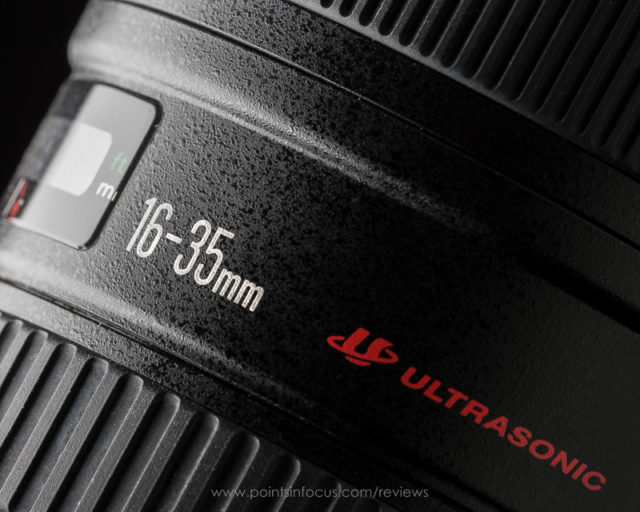
The finished is a slightly textured black. The coating is very durable and not prone to chipping, wearing, or scratching in my experience. If you’re looking at one of these on the used market, and the lens shows a lot of wear, the odds are good it’s been very heavily used.
The lens is built to tight tolerances to minimize dust and water entry; though it’s certainly not waterproof, it will shrug off drips and should shrug off rain. The lens mount is gasketed to fully seal when used with EOS-1D bodies. However, a front filter is necessary to complete the lens’s sealing.
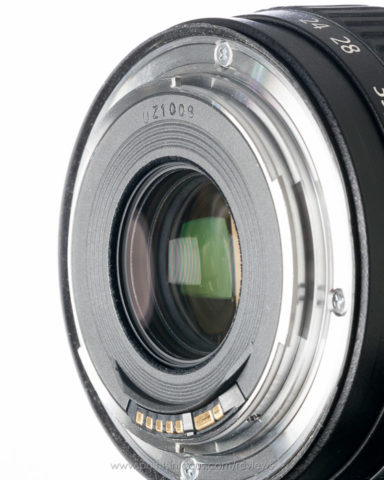
(Note: serial number has been cloned out.)
The controls are laid out following the traditional pro zoom layout pattern. Meaning the focus and zoom rings are about equally sized, and the focus ring is placed in the forward position with the zoom ring towards the rear. To round out the controls, the distance scale and AF/MF switch are fit between the focus and zoom rings, as they are on most of Canon’s L zooms.
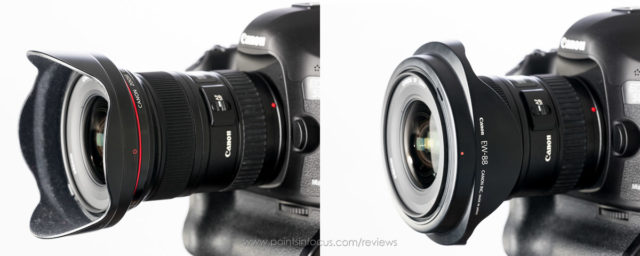
Like all Canon L lenses, the EF 16-35mm f/2.8L II USM comes with a lens hood (EW-88) in the box as well as a soft case (LP1319). The hood does provide shading at 16mm, but the extreme change in angle of view renders that largely moot at 35mm. As for physical protection, the hood doesn’t offer much of that either. It can be stored reversed on the front of the lens, and it doesn’t materially impede the operation of the lens from that position.
Filter Threads and Filters
Canon seems to go back and forth on what they make the filter threads from, on some lenses its plastic on others it’s metal. On this lens, the front most part of the lens that has both the filter threads and the hood mount is metal.
The 82mm filter threads are part of the external lens barrel, so neither focus or zoom actions affect the orientation of filters. When it was released in 2007, the EF 16-35mm f/2.8L II USM was one of the few L lenses that didn’t use 77mm filters. As it stands now, the bigger diameter filters appear to be here to stay, as Canon 2012 vintage EF 24-70mm f/2.8L II USM also uses the 82mm filter size.

There’s not much point to worrying about buying a bigger polarizer for this lens—though you’ll need an 82mm one for the new EF 24-70mm f/2.8L II USM. Using a polarizer with a wide or ultra-wide angle lens, will result in an uneven change in the sky’s color due to the massive angles of view covered.
If you’re a creative filter user who uses a system like the ones produced by Lee or Cokin, you may have problems, especially at the wide end. Though Lee users are less affected than Cokin users may be. For starters, the Cokin P system is completely unusable with this lens; the filter holder will show up in your images. You’ll need at least a Cokin Z-Pro (100mm) filter holder.
The issue is compounded if you’re using a protective filter to complete the sealing. At 16mm, with a screw in filter in place, the Cokin Z-pro mounting ring will vignette.
You’ll be severely limited by how many filters you can stack in your holders. For the Z-Pro system, any more than 1 filter slot and you start seeing the frames. Lee users may fair a bit better than Cokin users in this respect, as the Lee wide-angle adapters may push the filters back close enough that you might be able to use 2 filters instead of 1.
Focusing Controls
Manual
Continuing along the lens, the next major element is the focus ring. The rotating part of the focus ring is just a smidge over 1-inch wide, 26.56mm by my measure. However, only 3/4 of an inch (~19mm) is covered by the rubber grip material.
The focus ring’s rubber grip is ridged at 12.5 ridges per inch, compared to the 6.8 ridges per inch on the zoom ring. The different textures provide a tactile indication of which ring you’re touching/holding when you’re unable to see them, such as in the dark, and honestly, it’s a nice usability touch. Moreover, the differences are pronounced enough that it’s easily distinguishable without having to feel for fine details.
The EF 16-35mm f/2.8L II USM uses a ring ultrasonic AF motor and the ring’s input is mechanical not focus-by-wire. The biggest implication of this arrangement is the lack of hard stops at the close focus and infinity positions. You can feel when you reach the end of the focus travel in the focus ring, and there’s a marked but slight increase in resistance when you keep going.
Being an internal focus design, there’s not a lot of dynamic mass for the AF system to drive. As a result, AF performance is pretty snappy. Secondary effects of the internal focus design are that the resistance felt in the focus ring isn’t affected by lens orientation, and that the lens doesn’t extend while focusing.
That said, the lack of hard stops could be problematic for video shooters. Without hard stops on the lens, it’s possible to rotate a follow focus past the stop point, losing the alignment of focus marks in the process. Fortunately, many follow-focus manufacturers are adapting to these kinds of lenses and now include user-adjustable hard stops on the follow focus itself to overcome this problem.
Continuing aft along the lens barrel is the distance scale and AF/MF switch. Canon continues to put distance scales on mostly anything that’s higher end than a cheap kit lens. As far as features go, I’ve never been impressed with distance scales on AF lenses, especially the ones on modern AF lenses like this one.
The adaptations made in the move to autofocus cameras have removed much of the utility of distance scales on lenses. The focus throws on AF lenses are too small to really make printing and using much of the information on old style scales possible.
The EF 16-35mm f/2.8L II USM is no exception to that. In fact, it’s something of an extreme example of the problem. The focus ring only rotates about 90° in total. However, the first two marks, 0.28m and 0.5m are ~45° apart, moving to the next mark (1m) is only about ~15°, and another ~15° to the infinity position. The final 15, or so, degrees of rotation is taken up by the soft infinity stop.
Compounding the problems with this distance scale, for those of us stuck in antiquated Imperial or US Customary units of measure (feet and inches), the green printing used for the foot scale is extremely low contrast. Even in a relatively bright room, it can be hard to read unless there’s a light directly shining on it. In low light conditions, the situation is utterly hopeless without a flashlight.
In a very big way I think it’s time for camera makers to step up on the distance scale mark and do something useful and/or save the money and potential problems (the distance scale on Nikon’s 24-70mm f/2.8G was a source of a light leak in early models).
Moving counter-clockwise from the distance scale, there’s a bulge containing the autofocus/manual focus selector switch. The switch in approximately the 10 o’clock position, this puts it right about where the end of your thumb should be when holding the lens from below. The textured surface of the switch coupled with the stiffness of the switch makes it possible to change the switch’s position without taking your hand off the camera.
Zoom Controls and Operation
Continuing aft of the AF/MF switch and the distance scale is the zoom ring. The overall rotating portion of the zoom ring measures in at 15/16ths of an inch, just slightly smaller than the focus ring. Like the focus ring, not all of it is covered in rubber grip material. As I noted earlier the texturing on the grip is coarser than the focus ring’s to differentiate them by feel.
The rear edge of the zoom ring carries the printed focal length marks, with 16, 20, 24, 28, and 35mm being demarked. This is a true zoom lens, and all the intermediate positions are usable. Further, the lens will report and the camera will record in the EXIF data, all intermediate positions to the mm.
Like the EF 17-40mm f/4L USM and the EF-S 10-22mm f/3.5-4.5 USM, the EF 16-35mm f/2.8L II USM uses what I call a quasi-internal zoom configuration. The front element never extends past the front of the lens barrel, so the overall length of the lens never changes when the lens is zoomed. However, the front element does move during zooming.
The quasi-internal zoom design helps, but doesn’t eliminate, changes in resistance in turning the zoom ring depending on orientation of the lens. In the case of the EF 16-35mm f/2.8L II USM, I find it markedly easier to turn from 16mm to 35mm when the lens is pointing down—I’m at a loss to explain this, as the large front elements actually move up during that operation. There isn’t nearly as much of a difference between zooming in and out in any other orientation.
So now that I’ve looked at the outside of the lens, let’s talk briefly about the optics and performance.
Optical Performance
Historically, Canon has never been the best at building wide-angle lenses. That’s not to say the EF 16-35mm f/2.8L II USM sucks, it’s by far the best quality wide-angle zoom Canon makes, but there certainly are wide-angle zooms on other platforms that edge it out as best-in-class considering all platforms. That said, Canon has made steady progress over the years, and the EF 16-35mm f/2.8L II USM is definitely a cut above its predecessors.
Canon has also gone overboard on the camera-gear buzzword-bingo board. More than 30% of the 16 elements that make up the lens are some kind of special material or design. To help minimize spherical aberrations, coma, astigmatism, and distortion, there are 3 aspherical elements of 3 different types: ground, replica, and glass molded. In addition to the aspherical elements, there are 2 ultralow dispersion elements to counter chromatic aberrations.
So does all of that it work?
The answer seems to be, yes, more or less.
Though truthfully precisely quantifying a lens this wide is quite difficult for me, and given that I didn’t own a copy of its predecessor I can’t compare it to anything directly on a subjective level—well except for the EF-S 10-22mm f/3.5-4.5 USM, but the differences in platform make that problematic at best as well.
Central sharpness is good across the zoom range wide opened, and improves on stopping down. Edge and corner sharpness, however, isn’t nearly as good. I’ve certainly had images where in going back and looking at them critically I was disappointed with the edges and corners. The only real saving grace is that in a lot of cases with the 16-35, the corners and edges will be so distorted by perspective effects that the lack of resolving power won’t be real noticeable.
Vignetting, chromatic aberrations and distortion all exists to varying degrees. However, I see little point in spending much time talking about them as they can be removed in post processing with modern software, and in fact in the camera most modern EOS bodies.
Flare is decently controlled for such a wide-angle lens. It’s certainly never been an issue in my work, though I generally don’t shoot into such conditions without flagging the light source as much as possible.
Video Performance
With the advent of video capable DSLRs still lenses are increasingly being pressed into service for shooting video. For better or worse, this means talking about the performance of the lens under video conditions.
Breathing is the undesired change in framing when the lens is focused. It’s particularly problematic for scenes where focus is being racked between two subjects without the camera moving. Like most still camera lenses, the EF 16-35mm f/2.8L II USM isn’t optimized to minimize breathing, and as expected, it’s quite noticeable.
Parfocal stability is the ability of a lens to maintain a desired focus point when the lens is zoomed. The EF 16-35mm f/2.8L II USM isn’t not a parfocal lens. Though the massive depth of field coupled with the binning used to get 1080p video out of much higher resolution sensors mitigates the issues to some degree.
Image stabilization isn’t something you’d normally worry about on a wide-angle zoom. When shooting stills at 16mm the shutter speed can be allowed to drop as low as 1/15th of a second while still getting decent results. However, when handholding video it’s not motion blur in a single frame you’re worried about but the constant shaking from motion that you want to dampen. Sadly, the EF 16-35mm f/2.8L II USM doesn’t have an IS system, which means handheld movements won’t be as fluid as they would be with one unless you’re using an external camera stabilizer (like a glide cam or steady cam).
In the past, I typically have ignored APS-C performance for full frame lenses—in part, because I had nothing relevant to say about it—however, APS-C is close enough to the super-35 and is frequently being used in cinematic endeavors that it’s worth a minute to talk about. On an APS-C camera the EF 16-35mm f/2.8L II USM works out to be a wide (26mm in 35mm equivalent terms) to normal (56mm in 36mm equivalent terms) reasonably fast zoom.
The crop sensor seems to help breathing performance to a small degree. At 16mm, the full frame corners suffer from much more motion than they do on the crop camera, though breathing is still obvious and significant. At 35mm, focusing is fairly stable on the crop body, not quite breathing free, but free enough that it probably wont’t be a distraction.
Conclusions
For better or worse, the EF 16-35mm f/2.8L II USM is the best wide-angle zoom Canon currently offers for their full frame cameras. However, is it the best lens for you?
Being a zoom, it’s a compromise in quality for flexibility. The biggest compromise being that the corners and edges will be soft. For landscape shooters the corners don’t really improve by stopping down. Never mind the onward march of progress that has allowed Canon to improve their wide-angle lens design performance. Either the new IS wide-angle primes, or the wide-angle L primes would be a better option in terms of straight resolution for shooting landscapes.
For the entry-level generalist using say a 6D, I’m not sure I’d go this route either, though for me it’s a much more open question. The EF 17-40mm f/4L USM is smaller and lighter, though it doesn’t perform as well optically. If I was in this segment, and looking for a wide-angle zoom, I’d give consideration to both options and pick the one that better suited me.
For a crop shooter, there’s not a lot of reason to pursue the 16-35. The EF-S 17-55mm f/2.8 IS USM gives much better coverage on a crop camera, and being image stabilized it’s definitely more versatile both for stills and video. I think the better range and IS vastly outweigh the benefits of weather sealing, which is about the only advantage you get from the 16-35L in that situation.
All told, like many high-end lenses, I think the answer to the question of whether this is the right lens for you, is the old, “if you have to ask…” routine. The EF 16-35mm f/2.8L II USM is a good lens and the best option for a native wide-angle zoom for Canon users.
Personally, I really like shooting with my 16-35, though getting to get it out and use it seems to be something of a rarity for me these days. The extreme angle of view does allow you to distort reality in interesting ways, and that alone adds interest to your images, at least if you manage to use it right.

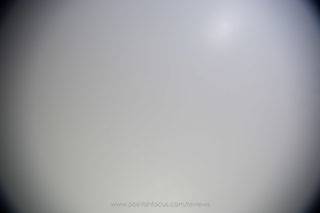
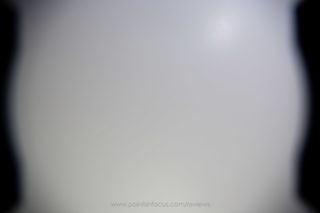
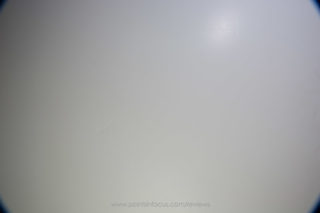
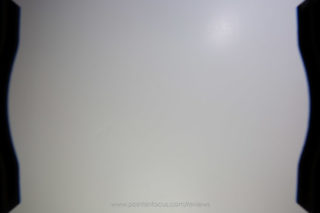
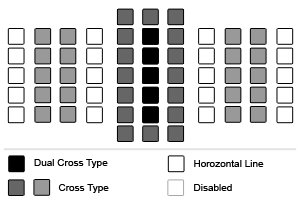
Comments
The filter holder called Novignett will eliminate all vignetting. Check out photo.net and search “per johannessen”. Look at the pictures and read the description. “freephotoguides” has this on their forums under Gear Talk.
@Per Frode Johannssen,
That’s certainly a workable approach. Though personally I don’t think I care for the trade offs I see in the design. While it certainly offers a lot more filter slots at ultra-wide focal lengths, I don’t find that more than 2, maybe 3 in a very rare case, are really needed for most work, at least my work. I can do that easily enough with a smaller Lee holder and their wide angle adapter rings.
I would also note, that the Cokin’s system is the worst case design for ultra-wide angle lenses. Lee’s system does a much better job. My quick test shows minimal vignetting with 2 slots and a protection filter on the lens, using Lee’s Ultra-wide angle adapters. With out a protection filter on the lens, I expect the Lee system should be able to deliver 3 slots with no vignetting issues at 16mm.
This is a great lens i agree with you. But what to you think about the newver version canon 16-35 f4 is? I think this new lens is far better, especialy in the corners.
@Fotograf Nunta,
I just took delivery of a EF 16-35mm f/4L IS USM, and am working on evaluating it and writing up a review on it. So far I’m very seriously impressed by it, especially in the corners. It’ll be a while until I get that review done, but my early impressions are it’s a very strong lens.